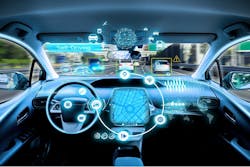Autonomous vehicles to transform the future of transportation
With the growing digital age, the transportation industry is rapidly evolving. Artificial intelligence and machine-learning technologies are trailblazing advancements in transportation. Enhanced technologies and automation in various vehicle systems have received a high acceptance rate amongst customers. With this evolving technology on board, the market has availability of autonomous vehicles from level 0 to level 6. Each automation level, from no driving automation to driving assistance, or from partial automation to conditional and high automation, has a varying degree of acceptance in the market. But acceptance of these autonomous vehicles in the market is increasing day by day.
Autonomous driving is futuristic, can eliminate traffic accidents, and can perform various tasks even without any involvement of a driver. For instance, the decrease in irregular stopping and driving of the vehicle will decrease traffic on the road, thus improving driving efficiency. The development of digital cities and reconfiguration of roads can accommodate self-driving transportation and increase the demand for autonomous vehicles in several ways. However, effective use of autonomous vehicles does require transformation of cities, towns, and roads. The upcoming advancements in vehicle automation are expected to improve travel and transportation in the coming years. At the same time, autonomous cars can benefit a person with disabilities too. People with vision, hearing, and movement impairments will have advanced mobility options with self-driving automobiles.
The transportation industry has been distressed due to the COVID-19 pandemic. There was a significant increase in online shopping since COVID-19. The shipping of an increased number of orders was quite challenging for the e-commerce sector, due to several restrictive norms, especially during the initial phase. These delivery robots were an acceptable solution for contactless delivery services, thus following social distancing laws. Some urban areas, hotels, corporate campuses were already using delivery robots; this is how the utilization of autonomous delivery systems highly increased, especially during the initial phase of the pandemic. These robots assisted with the safe delivery of medicine, groceries, and prepared meals, which was crucial amidst the rising cases.
Autonomous ride-sharing and self-driving taxis in urban areas are beneficial for college and office-goers. This is increasing the demand for autonomous vehicles and impels the market for top-notch technological innovations. General Motors and Waymo, Alphabet’s self-driving car company, are two of the major companies moving forward with business operations in the United States. Shanghai and Beijing in China have driverless fleets on roads, and China is looking to expand self-driving vehicle services in the future. Motional partnered with Hyundai Motor Group with a vision to provide all-electric robotaxis in the market. This IONIQ 5 robotaxi is a zero-emission taxi and will offer level 4 autonomy, thus providing safe driving without a driver. With level 4 autonomy, the car can operate in self-driving mode, but the driver can take control of the care and manually override the self-driving mode. According to Allied Market Research, the global autonomous vehicle market is expected to grow at a significant CAGR from 2019 to 2026. In the recent future, there will be self-driving trucks, autobus, and automation in ships and planes as well.
Beyond self-driving automobiles, artificial intelligence (AI) has several applications in vehicle engineering. Monitoring driver awareness is one of them and is potentially favorable. Numerous manufactures are now adopting in-car computer vision cameras to examine driver faces for tiny signs of exhaustion. This sign might provide an early warning of fatigue that may well lead to damage or severe accidents. Fatigue plays a role in 25% of fatal road accidents, thus making it an important instance in the vehicle automation industry.
The researchers at the University of Sydney have developed an "X-ray"-like vision tool for self-driving cars. The researchers have utilized collective perception with a vision to offer autonomous vehicles the potential to see through objects. Intelligent roadside units (or IRSUs) mounted on tall poles with a variety of sensors together with cameras and light detection ranging are used in this tool. These vision systems, autonomous cars, and IRSUs will exchange information internally, thus allowing a single vehicle to see things from different perspectives. This collective perception will help the vehicles examine things that are not in the direct range. This technology will assist the autonomous vehicle perceive pedestrians which are out of sight.
The development of fully autonomous vehicles is still in progress. It is a continual error-prone and repetitive development process that needs authentic data-driven research. The big names in the industry like Waymo (Alphabet), Ford, and Baidu announced to make their datasets publicly available. The importance of autonomous vehicles has increased like never before, and the market will have exponential growth in the future.
About the Author

Vaishanavi Kumbalwar
Vaishanavi Kumbalwar is a fun-loving, independent, unconventional and original thinker who loves to put her thoughts into words. She holds a bachelor’s degree in Mechanical Engineering and currently works as senior associate content writer at Allied Market Research. She thrives on challenges and loves to explore different writing styles to bring off her fondness for being a writer and blogger. She is an enthusiast of different cultures, places and cuisines and loves to travel off the tourist path and explore new things.
